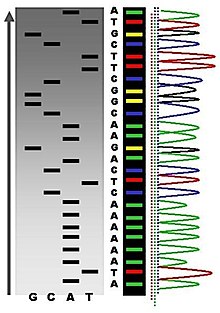 |
| Sanger sequencing |
Molecular biology deals with the structure and function of macromolecules, such as nucleic acids and proteins, which are essential to life. Molecular biology techniques are a set of tools and methods used by scientists to study and manipulate the structure and function of these macromolecules. Some common molecular biology techniques including:
- Polymerase chain reaction (PCR): This is a technique used to amplify a specific DNA sequence in order to make large amounts of a particular DNA fragment for further analysis. This is done by using special enzymes called polymerases to synthesize new strands of DNA complementary to the target sequence.
- Gel electrophoresis: This is a technique used to separate DNA or protein molecules based on their size and charge. A sample of DNA or protein is placed in a gel matrix, and an electric current is applied to the gel. The molecules migrate through the gel, and the smaller molecules move faster than, the larger ones, allowing them to be separated into distinct bands.
- DNA sequencing: This is a technique used to determine the order of the nucleotides in a DNA molecule. This is done by using special enzymes to break the DNA molecule into smaller fragments and then using dideoxynucleotides, which are nucleotides that can terminate DNA synthesis, to create a series of DNA fragments of known length. These fragments are then separated by gel electrophoresis, and the order of the nucleotides is determined by comparing the sequences of the fragments.
- Western blotting: This is a technique used to detect specific proteins in a sample. The sample is first separated by gel electrophoresis, and then the proteins are transferred from the gel to a membrane. The membrane is then incubated with antibodies that specifically bind to the target protein, and the presence of the protein is detected using a special detection method.
- Cloning: This is a technique used to create multiple copies of a specific DNA sequence. This is done by inserting the DNA sequence into a vector, such as a plasmid, which is then introduced into a host cell, such as a bacterial cell. The host cell replicates the vector and the inserted DNA sequence, producing multiple copies of the DNA.
These are just a few examples of the many molecular biology techniques that are used in research. These techniques have greatly advanced our understanding of the structure and function of macromolecules and have contributed to many important discoveries and advances in the fields of biology and medicine.
